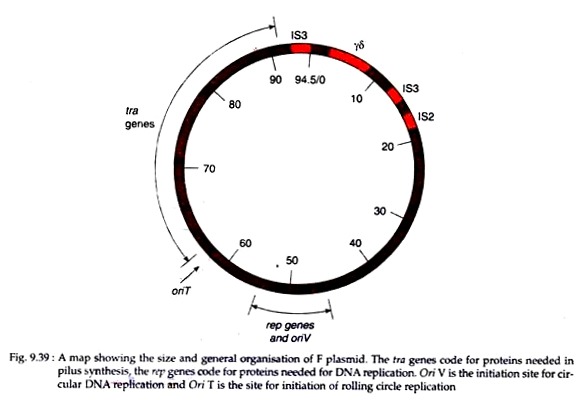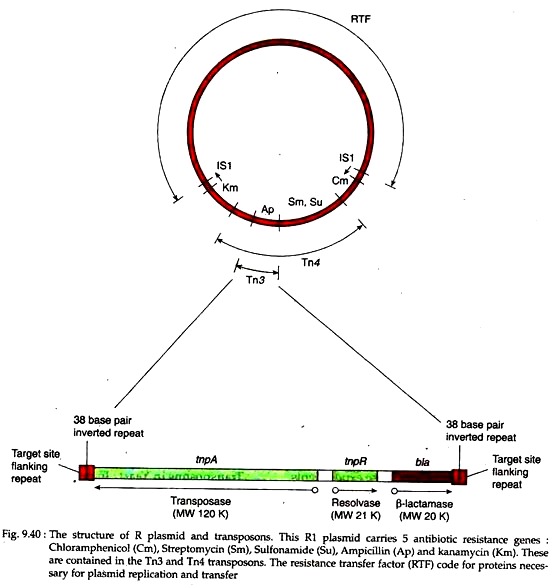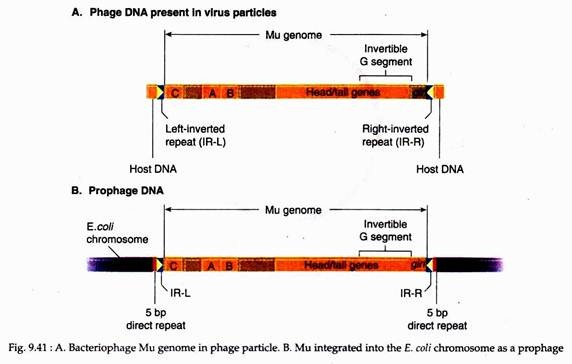The following points highlight the three main types of transposable elements found in plasmids. The types are: 1. F-Factor 2. R-Factor 3. Bacteriophage Mu.
1. F-Factor:
The transfer of genetic material between conjugating E. coli is the result of the function of a plasmid called fertility factor F. It is an extrachromosal circular double stranded DNA molecule capable of self-replication as well as integration into bacterial chromosome. Because of the capability of integrating, F factors are also called episomes.
The E. coli F factor is about 94.5 kilo-bases long and its important genetic elements are:
(i) Tra (transfer) genes that direct the formation of sex pili that attach the F+ cell to an F– cell,
ADVERTISEMENTS:
(ii) Rep genes that encode proteins required for the plasmid replication, and
(iii) Four IS elements, comprising of two copies of IS3, one of IS2 and one of insertion sequence element called уδ (gamma-delta) (Fig. 9.39). The E. coli chromosome has copies of these four ISs at various positions which made the F-factor possible to integrate into bacterial chromosome at specific sites and in different orientations. The F-factor integration occurs by conventional genetic recombination between the homologous sequences of the insertion elements.
2. R-Factor:
Plasmids having genes that code for enzymes capable of destroying or modifying antibiotics are called resistance factors (R factors) or R plasmids. They are not usually integrated into the host chromosome. Genetically, one segment of R plasmid is homologous to a segment in the F-factor and is required for conjugal transfer of genes.
ADVERTISEMENTS:
This segment and the plasmid specific genes for DNA replication constitute the RTF (resistance transfer factor) region (Fig. 9.40). The rest of the R plasmid differs from type to type and includes the antibiotic resistance genes or other genes of medical significance, such as resistance to heavy metal ions.
In R plasmids each resistance gene is located between flanking, directly repeated segments such as one of the IS modules. Thus, each transposon with its resistance gene in the R plasmid can be inserted into new locations on other plasmids or on the bacterial chromosome; at the same time leaving behind a copy of itself in the original position.
Transposons having antibiotic resistance genes play a major role in generating the plasmids. In an individual to whom drugs are being administered, any bacterium containing an R plasmid that is resistant to the drugs will be able to survive and propagate, whereas bacterium without resistance genes will be killed.
ADVERTISEMENTS:
Thus, there is selection pressure for new R plasmids to be produced by transposition of transposons that include genes for drug-resistance, especially when a person is exposed to drug therapy. Thus, R plasmids act as both the source and the target for transposons with resistance genes.
These new R plasmids can then be disseminated through populations of the same and other bacterial species by conjugation mediated by the RTF region of the plasmids.
3. Bacteriophage Mu:
The temperate bacteriophage Mu infects E. coli and can undergo both lytic and lysogenic phases. It is also a transposon and can cause mutation when transposes (the name Mu stands for Mutation). The genome of Mu consists of 37 bp long linear piece of DNA with unequal lengths of host DNA at the two ends (Fig. 9.41A).
At one end there is a G segment whose orientation is not fixed. When Mu infects E. coli and enters the lysogenic state, the Mu genome integrates into the host chromosome by conservative transposition to produce the integrated prophage DNA, flanked by a 5 bp direct repeat of host target site sequence (Fig. 9.41B). During such integration, the flanking host DNA that was present in the phage particle is lost. The Mu genome remains integrated throughout the lytic phase.
Replication of Mu genome occurs by replicative transposition. Transposition by Mu can cause different mutations like deletions, insertions and translocations. Deletion occurs if the two Mu pro-phages or transposons are in same orientation in the chromosome, while inversion occurs if the two are in opposite orientations.


